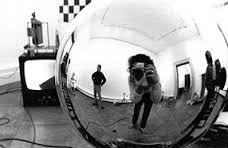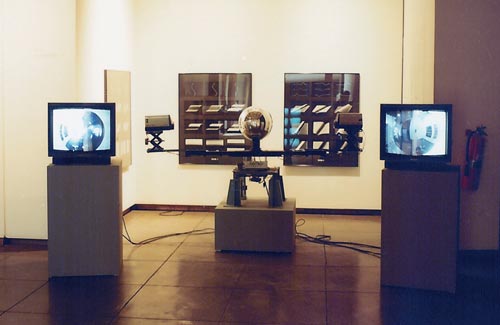Exploring the medium since the late 1960’s, Steina and Woody Vasulka’s inventive exploration of the new technology coined them as the pioneers of the video arts. The artistic married pair found their inspiration with experimentation of the technology of the moment and social issues of their time. In 1976 Steina (who only goes by her first name) brought her work Allvision to life, born from her research of perception. The installment bears two cameras facing each other on a horizontally rotating axis, in the middle stands a mirrored sphere. The two cameras, on a turntable, slowly orbit the mirrored sphere. Each camera visualizes one half of the reflected space, making the whole space observable as both cameras’ visual were transmitted to four monitors. [1]
The installation became an interactive piece between the gallery space, the recording, and the viewers themselves. The interaction between these three elements brought a rift between reality and perception. The view of the dismantled and fragmented gallery space was projected onto the flattened monitor screens, discoursing one’s own perception. Inspired by the “hegemony of the human eye, and why are we showing everything from this point of view, and who is the cameraman to tell the rest of the world what they can see” [1] Although Steina focused on the exploration of video and the visual reality and perception it creates, she forms a fissure between reality and visual perception. Therefore, implying that what is broadcasted is not necessarily accurate.



Numerous artists of the seventies like Steina and her husband Woody Vasulka who commandeered “the technologies of surveillance and control” to … “draw attention to the encroachment of privacy by corporations and governments.”[2] And yet as technology advances in this day and age and social issues are resolved, government surveillance is both still existent, and a realm in which artists nevertheless explore. Eric Eberhardt’s Art Radio channel, youarelisteiningto (2010) does just this. Accessing unencrypted police radio, and dissolving it with serene ambient music the listener is enraptured to a world of serenity, delinquency, allure and metropolitan living. The combination is nothing less than unprecedented audible experience. The art radio channel’s website, youarelistening.to, originally began with Los Angeles’ police stream and has since evolved and swelled to over 28 cities around the world, and in addition includes audible broadcasts from JFK, LAX, NASA and Twitter. Though Eberhardt’s intent originally drew focus from keeping an ear on the people who watch the public, after his creation he remarked, “‘Watching the Watchmen’ (so to speak) is developing an appreciation for how mundane and uncontroversial the majority of police work is” [3] Instead the true gravity of the mixed media project lies in this interaction between juxtaposing audios of the live police radio and the recorded music. Unfolding a haunting yet seductively beautiful commentary of urban living, the stream narrates and humanizes both the telling trivialities and tragedies of our cities. [3]
Citations:
[1]. Meigh-Andrews, Chris. A History of Video Art: The Development of Form and Function. Oxford: Berg, 2006. 155. Print.
[2]. Shanken, Edward A. Art and Electronic Media. Berlin: Phaidon, 2014.pg 120.
[3]. Callahan, Sophia. “Police Scanners And Ambient Music Fuse To Form Gorgeous Found Art Radio | The Creators Project.” The Creators Project. N.p., 10 Oct. 2014. Web. 04 Nov. 2014. <http://thecreatorsproject.vice.com/blog/police-scanners-and-ambient-music-fuse-to-form-gorgeous-found-art-radio>.
Images (left to right):
http://www.movingimagesource.us/articles/good-neighbors-20120503
http://www.vasulka.org/Steina/Steina_AllVision/AllVision.html
http://www.edith-russ-haus.de/no_cache/en/exhibitions/exhibitions/archive.html?tx_kdvzerhapplications_pi4%5Bexhibition%5D=38&tx_kdvzerhapplications_pi4%5Baction%5D=show&tx_kdvzerhapplications_pi4%5Bcontroller%5D=Exhibition
